The Hippo. King of the Rivers.

Despite its apparent tranquillity and its soft and jovial appearance, it is an animal with an irascible, unpredictable and aggressive character. The most dangerous and deadly in Africa. But you have to know it to appreciate it. Legendary origins.
The hippopotamus is one of the most dangerous, yet interesting, animals on the entire African continent. A large mammal (an adult male can weigh up to 3,200 kilos and be 1.6 metres tall), the hippopotamus is an essential feature of Africa’s rivers, lakes and bodies of water, and an important element in ecology.
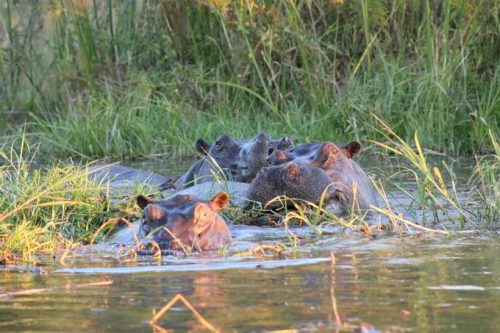
The hippopotamus is a vital part of Africa’s rivers, lakes, and waterways, and plays a significant role in ecology. Pixabay
Legend has it that when it was created, the hippopotamus was placed on land, but its passion for water led it to repeatedly pray to the Creator to place it in rivers and lakes. The Creator was reluctant, however, as he feared that an animal of its size would soon devour all the fish. The hippopotamus then promised to feed only on grass and to demonstrate its good faith, it would regularly open its jaws to show that it had not ingested any fish. It thus convinced the Creator and since then the hippopotamus has lived in the waters of African lakes and rivers.
Water Horse
This animal seems to be “designed” for the aquatic environment: eyes, nostrils and ears lie on the same plane (as in the crocodile), allowing the animal to keep them just above the surface while the rest of the body and much of the head remain submerged. As a result of its shape and enormous size, the hippopotamus floats with difficulty and, not being able to swim, it gallops skilfully on the seabed and it is precisely this characteristic that has earned it its name (from the Greek híppos, horse, and potamós, river).
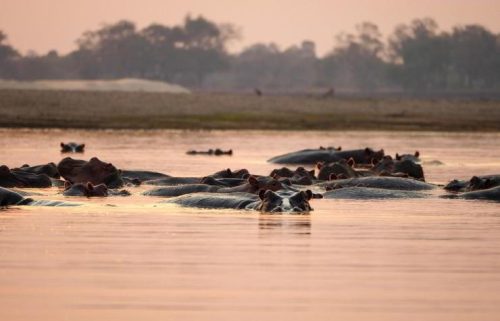
The hippo appears to be “designed” for the aquatic environment. Pixabay
Its essential symbiosis with water is due to the characteristics of its skin which, despite reaching a thickness of 6 centimetres, has a very thin epidermis, equipped with glands that secrete an oily and reddish protective liquid, but unsuitable for effectively protecting it from the sun’s rays, dehydration and overheating, thus forcing the animal to remain immersed in water for most of the day. Hippos therefore occupy any place with water deep enough to submerge themselves, allowing them to surface every 2-3 minutes to breathe, with plenty of grass nearby. The aquatic environment also provides them with protection; here they have virtually no enemies and even crocodiles keep away
from their powerful jaws.
Ferocious and lethal
Only when darkness falls do hippos leave the water to graze, travelling up to 40 kilometres a night and returning at dawn after eating about 40 kilos of grass. During the day, in the water, hippos show a certain degree of sociability, often gathering in groups that rest side by side. But on land, they become solitary and territorial.
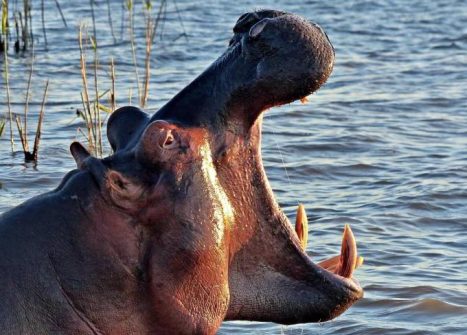
Their main weapon is their powerful jaws. Pixabay
Males mark their territory with abundant jets of faeces, using their tails to disperse them even in the water and defend their dominance with ferocious fights. Their main weapon is their powerful jaws, which can open in an impressive gesture of challenge, showing sharp canines that reach half a meter in length. Opening their jaws is an unmistakable sign of aggression, especially between males who begin to compete from the age of seven to establish precise hierarchies.
Very good for the environment
Females give birth to a calf after 6-8 months of gestation. Giving birth takes place in water. Mothers are very protective of their young and show aggression towards anyone who gets too close. The strong territoriality of the males and the strong sense of protection of the females make this animal very aggressive and dangerous for humans, both in water and on land.
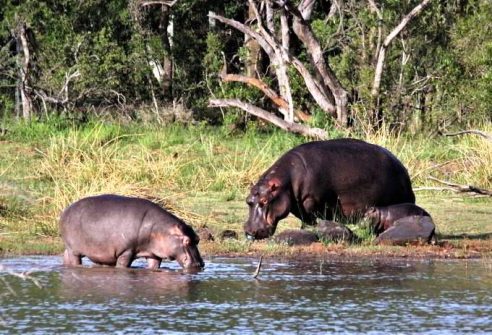
Females give birth to a calf after 6-8 months of gestation. Giving birth takes place in water. Pixabay
The number of victims that these enormous herbivores claim in a year (in Africa, about 500) is higher than the record for any other animal in Africa. But it would be unfair to talk about them as a threat. Hippos provide an important ecological contribution: they are responsible for both the creation of the main access routes to water where the banks of rivers and lakes are steep, and for the opening of paths in the bush, paths that are then taken by many other smaller animals, while their grazing keeps many species of grass at an optimal height, preventing them from deteriorating.
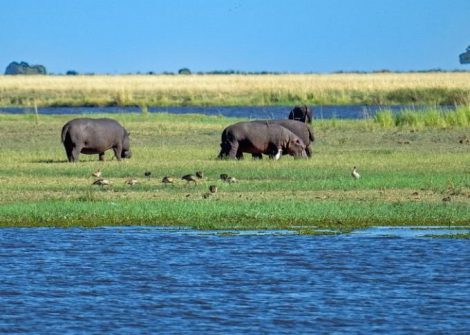
Hippos provide an important ecological contribution: while their grazing keeps many species of grass at an optimal height, preventing them from deteriorating. Pixabay
In the past, they suffered from excessive hunting pressure (the fat is very tasty and the skin is durable), conflict with humans and a reduction in habitat. The hippopotamus has faced difficulties but has returned to repopulate African waterways, thanks to the commitment of conservation authorities. Today its deep roar echoes in the African nights, reminding us that, although irascible, this “king of the river” is a fundamental pillar of the ecosystem, a grumpy but irreplaceable guardian of the
natural balance.
Gianni Bauce/Africa



